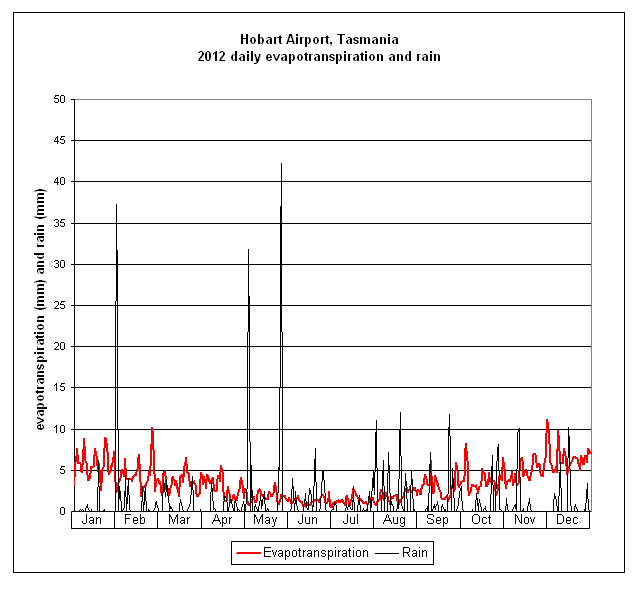Recently I was asked by a Queensland local government authority for advice about setback distances from a watercourse for an on-site domestic wastewater system. A site assessor engaged by the property owner had recommended a minimum setback distance of 5m. The Queensland Plumbing and Wastewater Code (2011) required a 50m minimum setback, but permitted an “Alternative Solution”. As it stood, the wastewater installation could not proceed, but the authority would accept my opinion as to whether the 50m limit could be reduced. Download my pdf which discusses (with an example) a defensible way to use the viral die-off method in Trench®3.0 to address this problem.
Archives for December 2013
Designing for failure?
An assessment report by a Tasmanian wastewater designer came my way recently. Here are the inputs to his system sizing
- House
- 3 bedroom; rainwater supply tanks
- Soil profile
- 0.1m of sand over heavy clay (massive structure)
- Adopted design loading rate
- 8L/m2/day (ie 8mm/day)
- Daily wastewater volume
- 600L/day (5 people at 120L/day each)
- Calculated basal absorption area
- 80m2
His wastewater design consisted of a septic tank (primary effluent) discharging via a splitter box to two standard trenches each 20m long, 2m wide and 0.6m deep.
I was handed a sample of the clay, and can confirm its “heaviness” — I pinched out a 5mm thick coherent ribbon to 150mm. I can’t confirm its structure in a hand-sized specimen though — as Australian New Zealand Standard 1547:2012 states in Section E6, …structure shall be assessed by examining exposed soil surfaces such as in a soil observation pit.
But let’s accept the designer’s statement that the clay was massively structured.
In Australia, AS/NZS1547:2012 calls this clay Category 6 (not good), says special designs are needed for wastewater disposal, and the effluent absorption rate should be based on permeability testing. I agree with the special designs part, but the last requirement is a bit of a problem. I know from experience that massive clay has a very low permeability. I can leave my Cromer permeameter overnight in a massive clay soil and come back next morning to find not even a drop has infiltrated. An on-line geotechnical database tells me that “inorganic clays of high plasticity” have permeabilities in the range 10-10 cm/sec to 10-7 cm/sec. Let’s be generous and take the high end of the range — it is equivalent to a permeability of 10-5 m/day. That’s 0.00001m/day. AS/NZS1547:2012 doesn’t help you translate this into an effluent absorption rate, but Trench®3 does. The answer is zero, or close to it.
This fits with our every day, common-sense experience. Rainwater puddles in clay lie around for days in a Tasmanian winter and only lose water through evaporation. Wastewater in a trench in heavy massive clay loses wastewater almost entirely via evapotranspiration. (Soils of course are rarely uniformly structured, and secondary porosity such as shrinkage cracks or defects around peds and clods in clay will allow some wastewater to infiltrate vertically downwards.)
Soil defects like these tend to close when the clay expands on wetting. But let’s be generous and allow a long-term vertically downward effluent absorption rate of (say) 1L/m2/day for our “massive” heavy clay. Then, if our system permits evapotranspiration, add 1 – 2L/m2/day for vertically upwards wastewater evapotranspiration loss in a Tasmanian winter, and perhaps 6 – 7L/m2/day in summer. These are figures for Hobart Airport, and in the accompanying graph, I’ve plotted the daily evapotranspiration and added daily rain for good measure. (They will of course vary from place to place. The design I’m talking about is close to the airport, and it’s valid to use these data.)
So, the effluent application rate (in Australia we call it the Design Loading Rate, or DLR) for massive clay soil near Hobart Airport varies seasonally, and ought to be around 7 – 8L/m2/day in summer, decreasing to about 2 – 3L/m2/day in winter. But our designer adopted a DLR of 8L/m2/day all year round, which in winter is (say) 5L/m2/day (5mm/day) too much. But the trench is not open space – let’s assume it is 50% voids. So 5mm of effluent raises the wastewater depth in the trench by 10mm each day (5mm divided by 0.5 = 10mm). Both trenches are bound to discharge horizontally (overflow!) in winter – and we haven’t added rain yet.
I never adopt a DLR for massive clay higher than 3L/m2/day. And to size wastewater systems I always do a full water balance which includes two inputs (rain and wastewater) and two outputs (evapotranspiration upwards and infiltration downwards) and trench storage volume. Trench®3 handles this easily.
 Graph plotting daily evapotranspiration and rain for Hobart Airport, Tasmania
Graph plotting daily evapotranspiration and rain for Hobart Airport, Tasmania